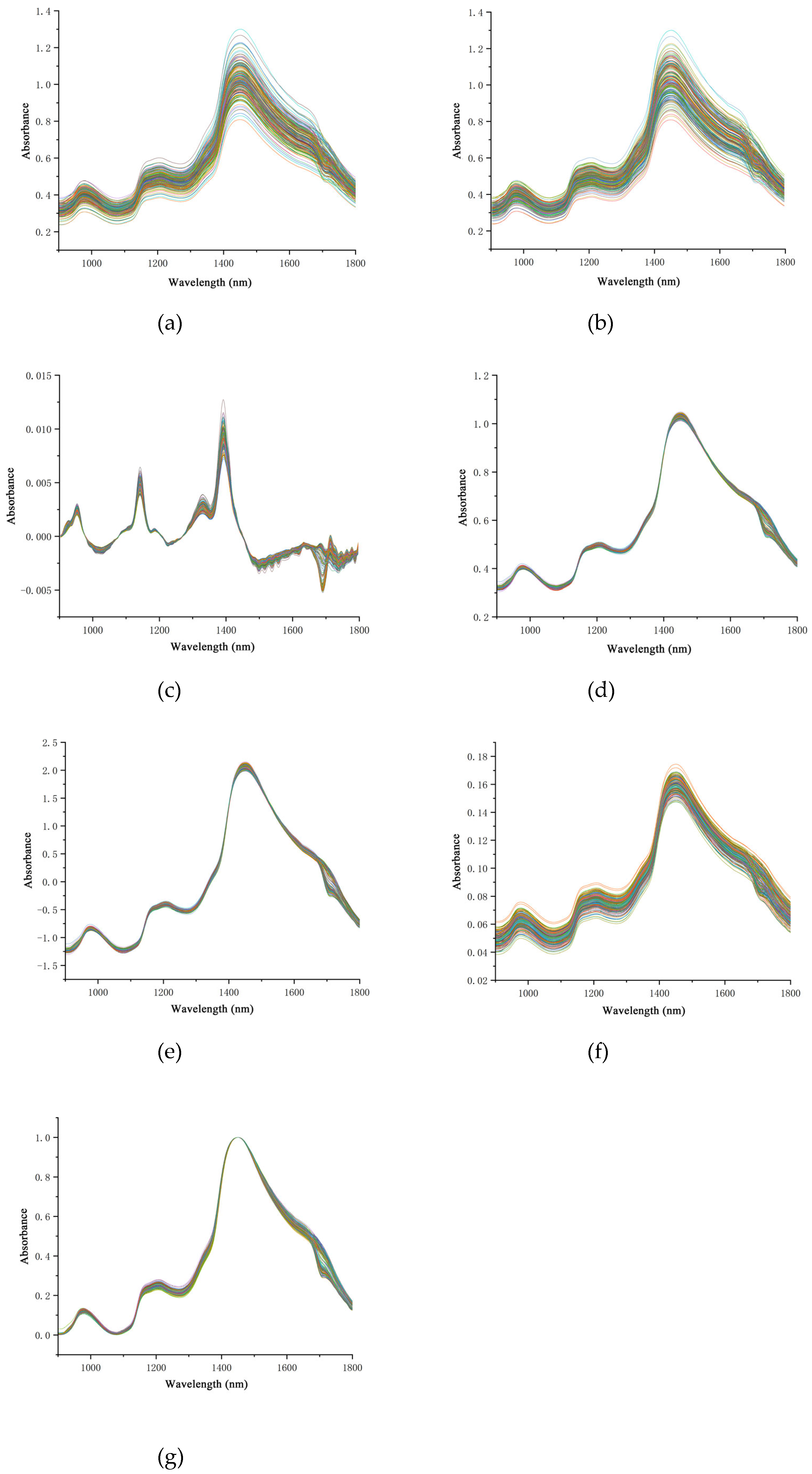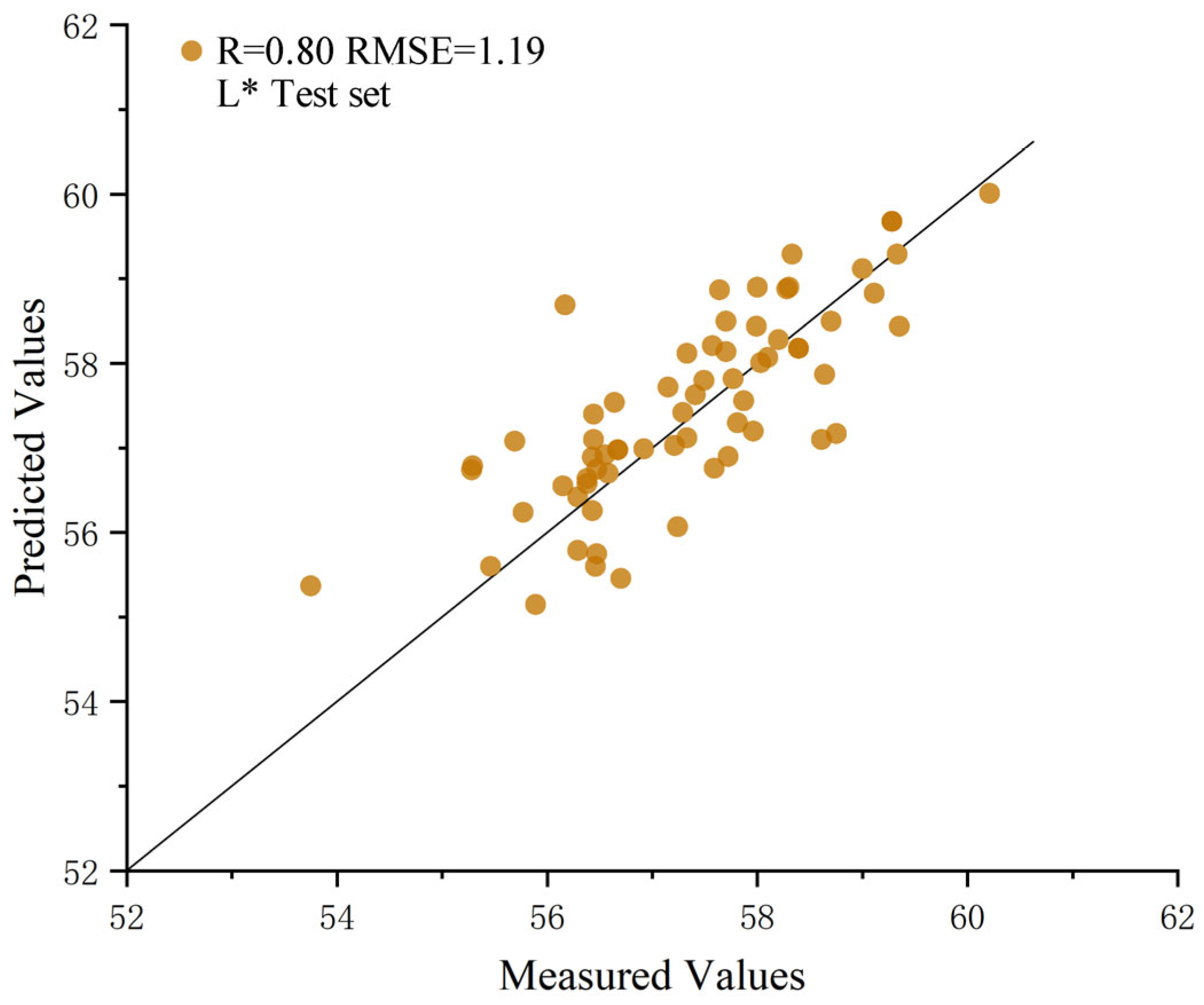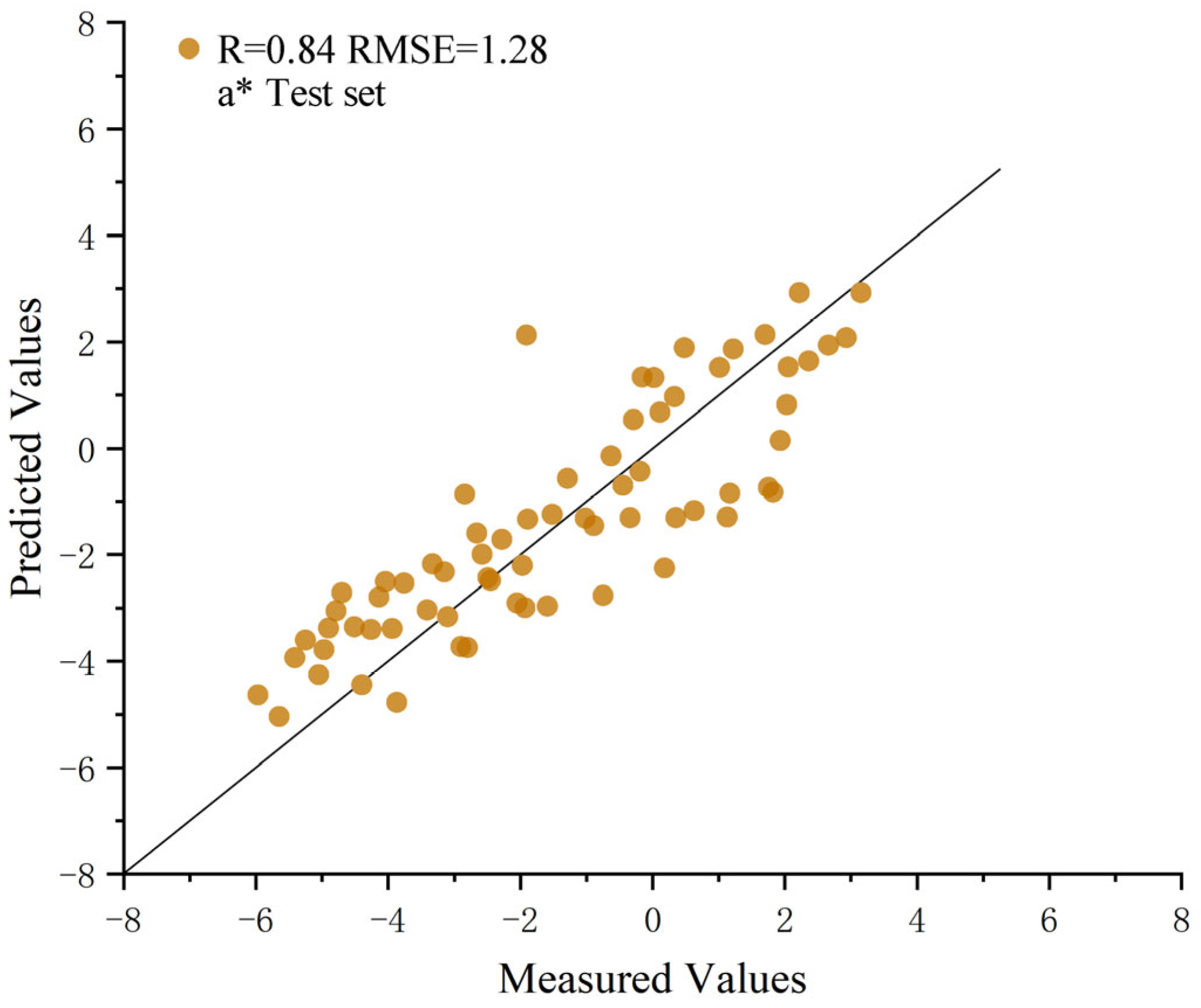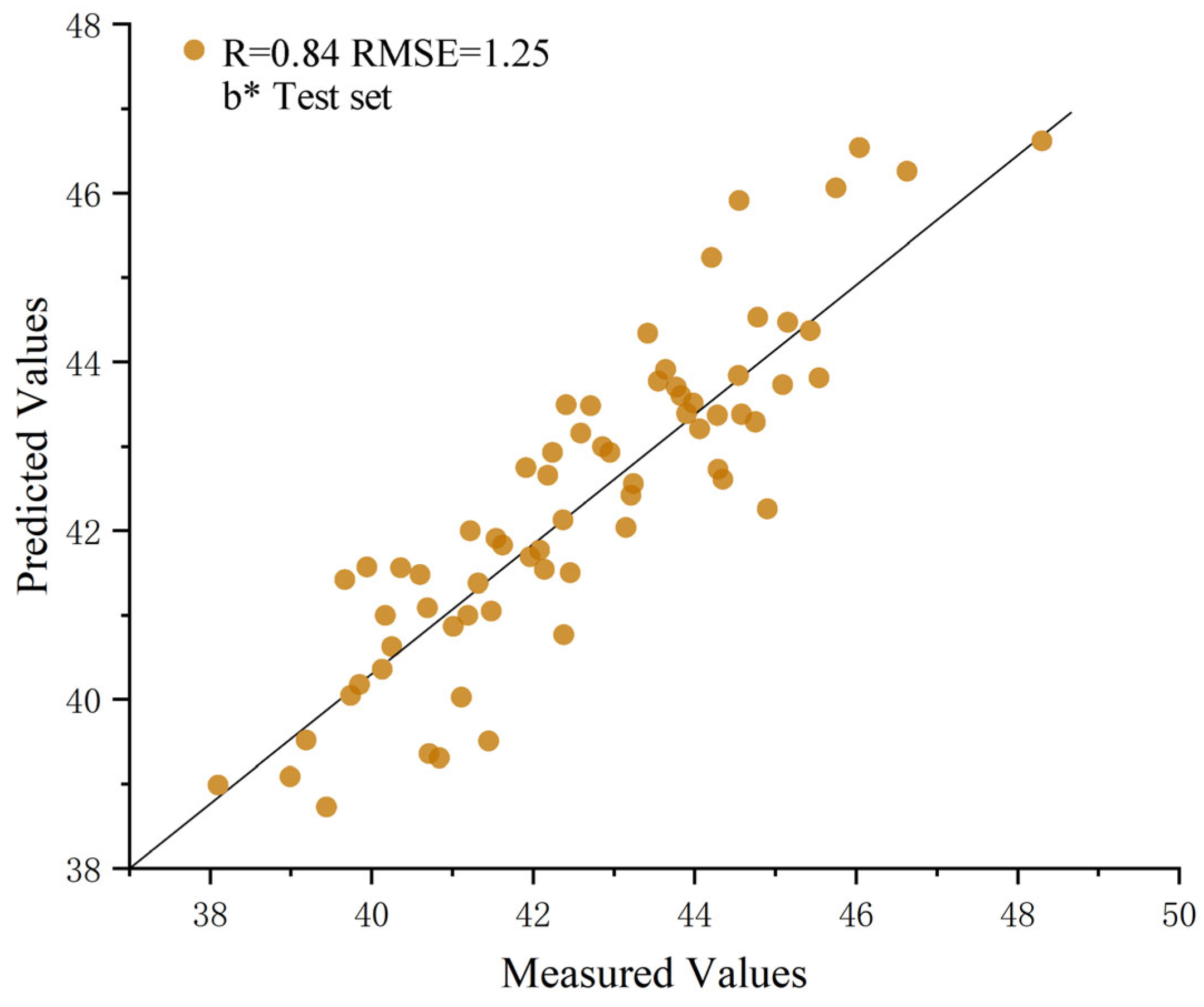Study on Color Detection of Korla Fragrant Pears by Near-Infrared Spectroscopy Combined with PLSR
Abstract
1. Introduction
2. Materials and Methods
2.1. Experimental Samples
2.2. Spectral Data Measurement
2.3. Color Measurement
2.4. Spectral Pre-Processing Methods
2.5. Characteristic Band Extraction Methods
2.6. Modeling Methods
2.7. Model Evaluation
3. Results and Analysis
3.1. Analysis of Full-Spectrum Data After Pre-Processing
3.2. Detection of the Color Index of Korla Fragrant Pears
3.3. Color Index Detection of Pears After Pre-Processing
3.4. Detection of Pear Color Indices After Characteristic Band Extraction
3.4.1. Detection of Pear Color Indices Based on UVE
3.4.2. Detection of Pear Color Indices Based on the SPA
3.4.3. Optimal Detection Models
4. Discussion
5. Conclusions
Author Contributions
Funding
Data Availability Statement
Acknowledgments
Conflicts of Interest
References
- Wang, B.H.; Sun, X.X.; Dong, F.Y.; Zhang, F.; Niu, J. Cloning and expression analysis of an MYB gene associated with calyx persistence in Korla fragrant pear. Plant Cell Rep. 2014, 33, 1333–1341. [Google Scholar] [CrossRef] [PubMed]
- Sardar, H. Fruit Quality Estimation by Color for Grading. Int. J. Model. Optim. 2014, 4, 38–42. [Google Scholar] [CrossRef][Green Version]
- Anjali; Ankita, J.; Ayushi, B.; Sadhna, M.; Ishika, J.; Nandini, P.; Nishita, S.; Nitiksha, J.; Renu, P.; Shakshi, K.; et al. State-of-the-art non-destructive approaches for maturity index determination in fruits and vegetables: Principles, applications, and future directions. Food Prod. Process. Nutr. 2024, 6, 56. [Google Scholar] [CrossRef]
- Huang, J.; Li, X.J. The Korla Fragrant Pear Color Grading Based on Colorimeter. North. Hortic. 2018, 17, 38–44. [Google Scholar]
- Qu, N.W.; Ma, B.X.; Wang, W.X. Color Grading of Korla Fragrant Pears Based on Neural Network and Machine Vision. J. Shihezi Univ. (Nat. Sci. Ed.) 2010, 28, 514–518. [Google Scholar] [CrossRef]
- Guo, S.P.; Huang, C.J.; Lu, Z.P. Application of Color Difference Meter in the Evaluation of Eggplant Color. Chin. Fruit Veg. 2022, 42, 61–65. [Google Scholar] [CrossRef]
- Yang, Z.Q.; Li, Z.M.; Hu, N.; Zhang, M.X.; Zhang, W.B.; Gao, L.X.; Ding, X.Y.; Qi, Z.P.; Duan, S.Y. Multi-Index Grading Method for Pear Appearance Quality Based on Machine Vision. Agriculture 2023, 13, 290. [Google Scholar] [CrossRef]
- Shao, Y.Y.; Ji, S.H.; Shi, Y.K.; Xuan, G.T.; Jia, H.J.; Guan, X.L.; Chen, L. Growth period determination and color coordinates visual analysis of tomato using hyperspectral imaging technology. Spectrochim. Acta Part A Mol. Biomol. Spectrosc. 2024, 319, 124538. [Google Scholar] [CrossRef]
- Rodríguez, P.; Villamizar, J.; Londoño, L.; Tran, T.; Davrieux, F. Quantification of Dry Matter Content in Hass Avocado by Near-Infrared Spectroscopy (NIRS) Scanning Different Fruit Zones. Plants 2023, 12, 3135. [Google Scholar] [CrossRef]
- Patel, D.; Bhise, S.; Kapdi, S.S.; Bhatt, T. Non-destructive hyperspectral imaging technology to assess the quality and safety of food: A review. Food Prod. Process. Nutr. 2024, 6, 69. [Google Scholar] [CrossRef]
- Nicácia, P.M.; José, C.F.; Simone, P.G.; Débora, L.B.; Mateus, S.P.; Juliano, D.S. Pear quality characteristics by Vis/NIR spectroscopy. An. Acad. Bras. Ciênc. 2012, 84, 853–863. [Google Scholar] [CrossRef]
- Liu, Y.D.; Chen, X.M.; Ouyang, A.G. Non-Destructive Measurement of Surface Color of Pearby Visible/Near-Infrared Diffuse Reflectance Spectra. J. Infrared Millim. Waves 2008, 4, 266–268. [Google Scholar]
- Che, J.; Liang, Q.; Xia, Y.; Liu, Y.; Li, H.; Hu, N.; Cheng, W.; Zhang, H.; Zhang, H.; Lan, H. The Study on Nondestructive Detection Methods for Internal Quality of Korla Fragrant Pears Based on Near-Infrared Spectroscopy and Machine Learning. Foods 2024, 13, 3522. [Google Scholar] [CrossRef] [PubMed]
- Kusumiyati, K.; Indah, K.; Oktavia, A.R. The color detection of two cucumber cultivars by NIR Spectroscopy. Asian J. Agric. 2017, 1, 59–65. [Google Scholar] [CrossRef]
- Chen, C.; Lu, X.X.; Zhang, P.; Chen, S.H.; Li, J.K. Measurement of surface color of Manai grape by VIS/NIR diffuse reflectance spectra. Food Ind. Div. 2019, 36, 308–311. [Google Scholar] [CrossRef]
- Mancini, M.; Mazzzoni, L.; Gagliardi, F.; Balducci, F.; Duca, D.; Toscano, G.; Mezzetti, B.; Capocasa, F. Application of the Non-Destructive NIR Technique for the Evaluation of Strawberry Fruits Quality Parameters. Foods 2020, 9, 441. [Google Scholar] [CrossRef]
- Zeng, S.C.; Zhang, Z.Y.; Cheng, X.D.; Cai, X.; Cao, M.K.; Guo, W.C. Prediction of soluble solids content using near-infrared spectra and optical properties of intact apple and pulp applying PLSR and CNN. Spectrochim. Acta Part A Mol. Biomol. Spectrosc. 2023, 304, 123402. [Google Scholar] [CrossRef]
- Liu, F.F. Key Technology Research and Application of Real-Time Non-Destructive Detection for Kiwifruit Sugar. Master’s Thesis, Xijing University, Xi’an, China, 2023. [Google Scholar] [CrossRef]
- Ping, F.J.; Yang, J.H.; Zhou, X.J. Quality Assessment and Ripeness Prediction of Table Grapes Using Visible-Near-Infrared Spectroscopy. Foods 2023, 12, 2364. [Google Scholar] [CrossRef]
- Toktam, M.M.; Seyed, M.A.R.; Ameneh, S.; Masoud, T. Predicting the moisture content and textural characteristics of roasted pistachio kernels using Vis/NIR reflectance spectroscopy and PLSR analysis. J. Food Meas. Charact. 2018, 12, 346–355. [Google Scholar] [CrossRef]
- Xie, C.J.; Qiao, M.M.; Yang, L.; Zhang, D.X.; Cui, T.; He, X.T.; Du, Z.H.; Xiao, T.P.; Li, H.S. Establishment of a general prediction model for protein content in various varieties and colors of peas using visible-near-infrared spectroscopy. J. Food Compos. Anal. 2024, 127, 105965. [Google Scholar] [CrossRef]
- Chen, D.J.; Jiang, P.H.; Guo, F.J.; Zhang, Y.H.; Zhang, C.F. Effects of Prediction Model of Kolar Pear Based on NIR Diffuse Transmission under Different Moving Speed on Online. Spectrosc. Spectr. Anal. 2020, 40, 1839–1845. Available online: https://www.gpxygpfx.com/CN/abstract/abstract11387.shtml (accessed on 24 March 2025).
- Chen, Q.M. Leaf Color Analysis and Color Application of Four Japanese Colorful Leaf Maple Based on Lab Model. Shandong For. Sci. Technol. 2019, 49, 37–40. [Google Scholar]
- Wang, F.; Liu, F.; Zhang, Y.Y.; Zhang, A.; Cao, Y.Z.; Li, J.Q.; Zhang, S.B. The study of applying CIE 1976 (L*a*b*) colour space in the measurement of colour of wine. Sino-Overseas Grapevine Wine 2015, 4, 6–11. [Google Scholar] [CrossRef]
- Sun, X.; Subedi, P.; Walker, R.; Walsh, K.B. NIRS prediction of dry matter content of single olive fruit with consideration of variable sorting for normalisation pre-treatment. Postharvest Biol. Technol. 2020, 163, 111140. [Google Scholar] [CrossRef]
- Peng, X.T.; Shi, T.Z.; Song, A.H.; Chen, Y.Y.; Gao, W.X. Estimating soil organic carbon using VIS/NIR spectroscopy with SVMR and SPA methods. Remote Sens. 2014, 6, 2699–2717. [Google Scholar] [CrossRef]
- Li, Q.Q.; Huang, Y.; Tian, K.D. Optimal modeling pattern of variables selection on analog complex using UVE-PLS regression. IOP SciNotes 2020, 1, 014201. [Google Scholar] [CrossRef]
- Wang, H.L.; Peng, J.P.; Xie, C.Q.; Bao, Y.D.; He, Y. Fruit Quality Evaluation Using Spectroscopy Technology: A Review. Sensors 2015, 15, 11889–11927. [Google Scholar] [CrossRef]
- Douglas, R.K.; Nawar, S.; Alamar, M.C.; Coulon, F.; Mouazen, A.M. Rapid detection of alkanes and polycyclic aromatic hydrocarbons in oil- contaminated soil with visible near-infrared spectroscopy. Eur. J. Soil Sci. 2019, 70, 140–150. [Google Scholar] [CrossRef]
- Wang, Z.Z.; Wu, Q.Y.; Kamruzzaman, M.H. Portable NIR spectroscopy and PLS based variable selection for adulterati ondetection in quinoa flour. Food Control 2022, 138, 108970. [Google Scholar] [CrossRef]
- Ezenarro, J.; Schorn-García, D.; Aceña, L.; Mestres, M.; Busto, O.; Boqué, R. J-Score: A new joint parameter for PLSR model performance evaluation of spectroscopic data. Chemom. Intell. Lab. Syst. 2023, 240, 104883. [Google Scholar] [CrossRef]
- Lukinac, J.; Mastanjević, K.; Mastanjević, K.; Nakov, G.; Jukić, M. Computer Vision Method in Beer Quality Evaluation—A Review. Beverages 2019, 5, 38. [Google Scholar] [CrossRef]
- Liu, D.Y.; Wang, E.F.; Wang, G.L.; Ma, G.K. Nondestructive determination of soluble solids content, firmness, and moisture content of “Longxiang” pears during maturation using near-infrared spectroscopy. J. Food Process. Preserv. 2022, 46, e16332. [Google Scholar] [CrossRef]
- Hao, Y.; Sun, X.D.; Pan, Y.Y.; Gao, R.J.; Liu, Y.D. Detection of Firmness and Surface Color of Pear by Near Infrared Spectroscopy Based on Monte Carlo Uninformative Variables Elimination Method. Spectrosc. Spectr. Anal. 2011, 31, 1225–1229. [Google Scholar]
- Lu, B.; Liu, N.H.; Li, H.L.; Yang, K.F.; Hu, C.; Wang, X.F.; Li, Z.X.; Shen, Z.X.; Tang, X.Y. Quantitative determination and characteristic wavelength selection of available nitrogen in coco-peat by NIR spectroscopy. Soil Tillage Res. 2019, 191, 266–274. [Google Scholar] [CrossRef]





| Indicator | Maximum | Minimum | Average | Standard Deviation |
|---|---|---|---|---|
| L* | 63.71 | 51.1 | 58.12 | 2.32 |
| a* | 7.33 | −6.21 | −1.24 | 2.69 |
| b* | 48.30 | 33.57 | 42.45 | 2.38 |
| Test Index | Pre-Processing Method | Test Set | |
|---|---|---|---|
| R | RMSE | ||
| L* | No pre-processing | 0.68 | 1.58 |
| SGCD | 0.70 | 1.45 | |
| SGCS | 0.68 | 1.42 | |
| VN | 0.70 | 1.40 | |
| MMN | 0.68 | 1.54 | |
| MSC | 0.69 | 1.41 | |
| SNV | 0.68 | 1.51 | |
| a* | No pre-processing | 0.69 | 1.70 |
| SGCD | 0.71 | 1.62 | |
| SGCS | 0.74 | 1.48 | |
| VN | 0.73 | 1.54 | |
| MMN | 0.72 | 1.48 | |
| MSC | 0.75 | 1.59 | |
| SNV | 0.71 | 1.51 | |
| b* | No pre-processing | 0.71 | 1.76 |
| SGCD | 0.75 | 1.51 | |
| SGCS | 0.72 | 1.58 | |
| VN | 0.73 | 1.50 | |
| MMN | 0.71 | 1.69 | |
| MSC | 0.73 | 1.62 | |
| SNV | 0.69 | 1.78 | |
| Test Index | Pre-Processing Method | Test Set | |
|---|---|---|---|
| R | RMSE | ||
| L* | SGCS | 0.73 | 1.54 |
| SGCD | 0.80 | 1.19 | |
| VN | 0.73 | 1.49 | |
| MMN | 0.76 | 1.35 | |
| MSC | 0.75 | 1.41 | |
| SNV | 0.78 | 1.32 | |
| a* | SGCS | 0.79 | 1.69 |
| SGCD | 0.81 | 1.51 | |
| VN | 0.79 | 1.58 | |
| MMN | 0.83 | 1.56 | |
| MSC | 0.82 | 1.52 | |
| SNV | 0.83 | 1.51 | |
| b* | SGCS | 0.83 | 1.42 |
| SGCD | 0.84 | 1.28 | |
| VN | 0.81 | 1.31 | |
| MMN | 0.84 | 1.34 | |
| MSC | 0.84 | 1.25 | |
| SNV | 0.81 | 1.42 | |
| Test Index | Pre-Processing Method | Test Set | |
|---|---|---|---|
| R | RMSE | ||
| L* | SGCS | 0.74 | 1.42 |
| SGCD | 0.72 | 1.34 | |
| VN | 0.78 | 1.39 | |
| MMN | 0.78 | 1.34 | |
| MSC | 0.74 | 1.31 | |
| SNV | 0.73 | 1.37 | |
| a* | SGCS | 0.80 | 1.59 |
| SGCD | 0.79 | 1.65 | |
| VN | 0.84 | 1.28 | |
| MMN | 0.81 | 1.52 | |
| MSC | 0.80 | 1.49 | |
| SNV | 0.83 | 1.46 | |
| b* | SGCS | 0.84 | 1.42 |
| SGCD | 0.83 | 1.28 | |
| VN | 0.81 | 1.29 | |
| MMN | 0.79 | 1.37 | |
| MSC | 0.83 | 1.36 | |
| SNV | 0.82 | 1.29 | |
| Test Index | Pre-Processing Method | Characteristic Extract Extraction | Training Set | Test Set | RPD | RER | ||
|---|---|---|---|---|---|---|---|---|
| R | RMSE | R | RMSE | |||||
| L* | MMN | SPA | 0.78 | 1.46 | 0.78 | 1.34 | 1.73 | 9.41 |
| SGCD | UVE | 0.84 | 1.15 | 0.80 | 1.19 | 1.95 | 10.60 | |
| a* | VN | SPA | 0.85 | 1.39 | 0.84 | 1.28 | 2.10 | 10.58 |
| SNV | UVE | 0.85 | 1.49 | 0.83 | 1.51 | 1.78 | 8.97 | |
| b* | SGCD | SPA | 0.85 | 1.26 | 0.83 | 1.28 | 1.86 | 11.51 |
| MSC | UVE | 0.84 | 1.21 | 0.84 | 1.25 | 1.90 | 11.78 | |
Disclaimer/Publisher’s Note: The statements, opinions and data contained in all publications are solely those of the individual author(s) and contributor(s) and not of MDPI and/or the editor(s). MDPI and/or the editor(s) disclaim responsibility for any injury to people or property resulting from any ideas, methods, instructions or products referred to in the content. |
© 2025 by the authors. Licensee MDPI, Basel, Switzerland. This article is an open access article distributed under the terms and conditions of the Creative Commons Attribution (CC BY) license (https://creativecommons.org/licenses/by/4.0/).
Share and Cite
Xia, Y.; Liu, Y.; Zhang, H.; Che, J.; Liang, Q. Study on Color Detection of Korla Fragrant Pears by Near-Infrared Spectroscopy Combined with PLSR. Horticulturae 2025, 11, 352. https://doi.org/10.3390/horticulturae11040352
Xia Y, Liu Y, Zhang H, Che J, Liang Q. Study on Color Detection of Korla Fragrant Pears by Near-Infrared Spectroscopy Combined with PLSR. Horticulturae. 2025; 11(4):352. https://doi.org/10.3390/horticulturae11040352
Chicago/Turabian StyleXia, Yifan, Yang Liu, Hong Zhang, Jikai Che, and Qing Liang. 2025. "Study on Color Detection of Korla Fragrant Pears by Near-Infrared Spectroscopy Combined with PLSR" Horticulturae 11, no. 4: 352. https://doi.org/10.3390/horticulturae11040352
APA StyleXia, Y., Liu, Y., Zhang, H., Che, J., & Liang, Q. (2025). Study on Color Detection of Korla Fragrant Pears by Near-Infrared Spectroscopy Combined with PLSR. Horticulturae, 11(4), 352. https://doi.org/10.3390/horticulturae11040352







